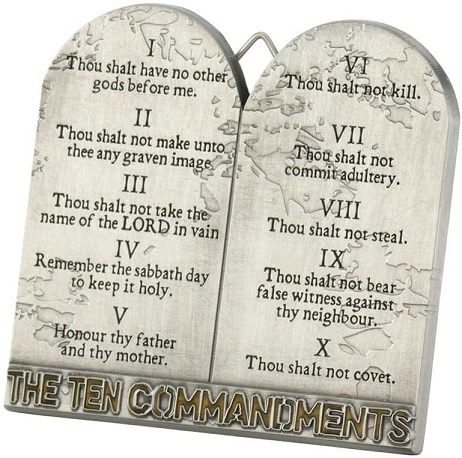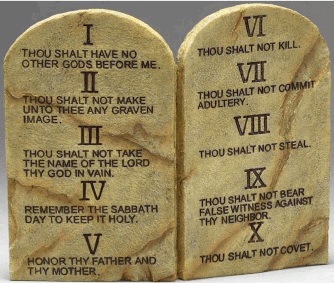The following is a first draft for what I hope will become the follow-up to “Have To” History: Landmark Supreme Court Cases. I’m sharing some of the chapters as they’re written, partly to share with you, my Eleven Faithful Followers, and partly because nothing brings out the typos, grammar errors, and other shortcomings like publishing something online. Enjoy.
FOLLOW UP: The final version of this one (and the one that ended up in the book) can be found here.
Thou Shalt Post These In Every Classroom
Three Big Things:
1. Kentucky required that the Ten Commandments be posted in all public school classrooms without comment, but with a little disclaimer underneath about them being the “fundamental legal code of Western civilization.”
2. The Court applied the “Lemon Test” and determined that the legislation had no clear secular purpose; it was thus a violation of the Establishment Clause of the First Amendment.
3. Whereas recent cases had dealt with efforts to support the secular education of students in religious schools without running afoul of the “wall of separation,” Stone marked a new generation of cases focused on the reverse – seeing just how far religion could be brought back into public schooling.
Background
 The Supreme Court’s decision in Stone v. Graham was announced on November 17th, 1980. Less than two weeks earlier, Ronald Reagan had been elected President of the United States, initiating what would later be called the “Reagan Revolution” – a resurgence of conservative values and policies anchored in an idealized past. The events leading to Stone began years earlier, but its outcome sent a message to the faithful in the 1980s similar to that of Engel v. Vitale and Abington v. Schempp two decades before: American’s fundamental values (meaning public promotion of Christianity) were under attack by intellectual elitists… aka “liberals.” And some of them wore robes.
The Supreme Court’s decision in Stone v. Graham was announced on November 17th, 1980. Less than two weeks earlier, Ronald Reagan had been elected President of the United States, initiating what would later be called the “Reagan Revolution” – a resurgence of conservative values and policies anchored in an idealized past. The events leading to Stone began years earlier, but its outcome sent a message to the faithful in the 1980s similar to that of Engel v. Vitale and Abington v. Schempp two decades before: American’s fundamental values (meaning public promotion of Christianity) were under attack by intellectual elitists… aka “liberals.” And some of them wore robes.
Less than a month after Stone was decided, John Lennon was assassinated. In January of 1981, Reagan took office and began “making America great again.” The symbolism is purely retrospective; it’s not like the 1970s had been great for either side of the cultural divide. The U.S. had weathered Watergate, Vietnam, and a major energy crisis before succumbing to disco, of all things. Cult-leader “Reverend” Jim Jones had recently led his followers in mass suicide, the horrifying event from which the phrase “drinking the Kool-Aid” was coined. As the new year began, the U.S. was on Day 400-plus of the Iranian Hostage Crisis. Everyone knew the exact number each day because the evening news led with it every night.
The “Miracle on Ice” at the 1980 Olympics was nice, but it already felt like a LONG time ago.
In short, there are many for whom it may not have seemed like such a bad time to try to slip some old-time religion back into the classroom, and nothing was more old-time-y than the Ten Commandments.
Rules to Live By
There’s nothing like a decade or two of perceived dissolution and chaos to make law-and-order look wonderfully shiny and assuring, and the Decalogue fit the bill perfectly. It offered clear guidelines for proper living, literally set in stone, but minus the sort of detailed penalties and depressing legalistic minutia spelled out elsewhere in the Old Testament.
It didn’t hurt that it was more-or-less universally revered – Protestants, Catholics, even Jews liked it! (You know, all the REAL religions.) What more could one ask?
The State of Kentucky required that a copy of the Ten Commandments be posted on the wall of every public school classroom. The Commandments were purchased via private contributions, so no state money was used, and teachers were not required to discuss, promote, or even draw attention to the Commandments so posted. At the bottom of each copy was this explanation:
The secular application of the Ten Commandments is clearly seen in its adoption as the fundamental legal code of Western Civilization and the Common Law of the United States.
And yet, there were a few parents who for some reason thought this might violate the Establishment Clause. The case worked its way through the courts until it was accepted on appeal by the big one.
The Decision
The Court’s 5 – 4 decision was nevertheless issued per curiam, meaning “by the court.” Per curiam decisions are traditionally for situations in which there was little need to elaborate on constitutional reasoning and the Court was so united as to eliminate the need for an identifiable voice speaking for the whole. Gradually over the course of the 20th century, however, the Court began allowing concurring opinions to per curiam decisions, then dissents… and eventually it became an unacknowledged tool for avoiding personal responsibility for controversial ideas or arguments.
In other words, per curiam opinions periodically allow a degree of avoidance and misdirection from a body otherwise recognized as unflinching and unafraid.
The Court’s anonymous majority opinion revisited the three-part “Lemon Test” laid out less than a decade before in Lemon v. Kurtzman (1971). Part one stated that in order to pass constitutional muster, a law must have a secular purpose to begin with. Clearly, the Court argued, that was not the case here. The Ten Commandments weren’t being used to study the evolution of written law, or in comparative religion, or even as literature or general history. They were just… there.
This is not a case in which the Ten Commandments are integrated into the school curriculum, where the Bible may constitutionally be used in an appropriate study of history, civilization, ethics, comparative religion, or the like. Posting of religious texts on the wall serves no such educational function. If the posted copies of the Ten Commandments are to have any effect at all, it will be to induce the schoolchildren to read, meditate upon, perhaps to venerate and obey, the Commandments. However desirable this might be as a matter of private devotion, it is not a permissible state objective under the Establishment Clause.
Nor was the majority impressed by the State’s “Religious values? Are they really?” defense:
The preeminent purpose for posting the Ten Commandments on schoolroom walls is plainly religious in nature. The Ten Commandments are undeniably a sacred text in the Jewish and Christian faiths, and no legislative recitation of a supposed secular purpose can blind us to that fact…
We conclude that {this legislation} violates the first part of the Lemon v. Kurtzman test, and thus the Establishment Clause of the Constitution.
Having failed the first test, there was no reason to discuss the remaining two. End of story.
The Dissent(s)
Four justices disagreed, but only one went to the trouble to elaborate as to why. Judging from his tone, Justice William Rehnquist (who’d later become Chief Justice) was shocked and a tad appalled that the Court wouldn’t simply take state legislators at face value when they explained that posting religious laws without context in every school classroom regardless of age level or subject matter was actually part of a very important historical lesson on the evolution of Occidental jurisprudence. Because isn’t that normally how lesson plans are put together – mass stapling of posters paid for by outsiders?
Rehnquist quotes from previous decisions extensively and rather effectively:
The Establishment Clause does not require that the public sector be insulated from all things which may have a religious significance or origin. This Court has recognized that “religion has been closely identified with our history and government” (Abington School District v. Schempp, 1963) and that “[t]he history of man is inseparable from the history of religion” (Engel v. Vitale, 1962). Kentucky has decided to make students aware of this fact by demonstrating the secular impact of the Ten Commandments…
What was arguably his strongest rhetorical moment, however, came in one of his footnotes:
The Court’s emphasis on the religious nature of the first part of the Ten Commandments is beside the point. The document as a whole has had significant secular impact, and the Constitution does not require that Kentucky students see only an expurgated or redacted version containing only the elements with directly traceable secular effects.
Aftermath
Stone was one of the first cases to rule that even a “passive display” of religion could nevertheless violate the Establishment Clause. It was from this reasoning the Court would subsequently take issue with certain government-sponsored Christmas displays and other state-sanctioned religious ceremonies. The Ten Commandments in particular would become a symbolic “line in the sand” on various state capital grounds or displayed in a public building or two. Consistent with the Court’s decision in Stone, decisions in those future cases would often come down to context – where were they posted, how were they presented, and why were they included?
The 1980s would see a minor explosion of cases directly or indirectly related to the “wall of separation” between religion and public education. The question of equitable facility usage became a thing – can schools who allow community groups to meet on school grounds after-hours deny the same opportunity to religious groups? (Spoiler: Nope.) Indirect aid to religious institutions via tax credits for parents, secular school supplies, or simply sending over teachers kept coming before the Court, always in slightly different forms and forcing the Court to continually revise their solutions. There was even a brief foray into “Evolution vs. Creationism” before the decade was out.
By far the most interesting cases, however, would be ever-shifting efforts to circumvent Engel, Abington, and the rest by testing one problematic element at a time. Eventually, all sorts of religious expression in public schools would be framed as “student led,” but in the 80s it started much more simply. What if schools weren’t posting commandments, reading Bible verses, or leading students in prayers? What if every day simply began with a… “moment of silence”?
Turns out that one will be hard to dispute, no matter how obvious the intent. The right was finally going to have a few wins.
RELATED POST: A Wall of Separation – The Ten Commandments (Part One)
RELATED POST: A Wall of Separation – The Ten Commandments (Part Two)
RELATED POST: “Have To” History – Zorach v. Clauson (1952)

 On November 17, 1980, the Supreme Court announced its decision in Stone v. Graham – a case involving the required posting of the Ten Commandments on the wall of every classroom in Kentucky.
On November 17, 1980, the Supreme Court announced its decision in Stone v. Graham – a case involving the required posting of the Ten Commandments on the wall of every classroom in Kentucky.